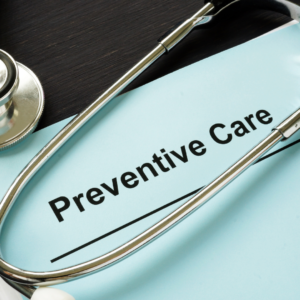
by admin | Jun 24, 2024 | Health & Wellness
 The old adage “an ounce of prevention is worth a pound of cure” rings truer than ever in today’s world. While reactive healthcare plays a crucial role in treating illness, a growing emphasis is being placed on the power of health prevention and wellness.
The old adage “an ounce of prevention is worth a pound of cure” rings truer than ever in today’s world. While reactive healthcare plays a crucial role in treating illness, a growing emphasis is being placed on the power of health prevention and wellness.
Investing in preventive measures and promoting overall well-being isn’t just about individual health; it’s a strategic decision with far-reaching benefits for individuals and communities. Here’s why:
Reduced Healthcare Costs:
Reactive healthcare, focused on treating existing conditions, can be incredibly expensive. Chronic diseases like heart disease, diabetes, and cancer often require ongoing treatment and management, placing a significant strain on healthcare systems and individuals’ finances.
Investing in preventive measures like healthy eating, regular exercise, and preventive screenings can significantly reduce the risk of developing these chronic conditions, leading to substantial cost savings in the long run.
Improved Quality of Life:
Health prevention isn’t just about avoiding illness; it’s about promoting overall well-being. By prioritizing healthy habits, individuals experience increased energy levels, improved mental clarity, and a greater sense of vitality. This leads to a higher quality of life, allowing individuals to be more productive, engaged, and fulfilled in all aspects of their lives.
Enhanced Productivity and Economic Growth:
A healthy workforce is a productive workforce. When individuals are free from chronic illness and experience better overall health, they are more likely to be present at work, focused on their tasks, and less prone to absenteeism due to health issues. This translates to increased productivity and economic growth for both individuals and organizations.
Strategies for Investing in Health Prevention:
Investing in health prevention can take various forms, both at an individual and community level:
- Individual Level: Prioritizing healthy eating habits, regular exercise, adequate sleep, and preventive screenings are essential steps individuals can take to safeguard their health.
- Community Level: Promoting access to healthy food options, safe parks and recreational facilities, and community-based wellness programs can significantly impact population health.
Investing in health prevention and wellness is a wise decision with far-reaching benefits. By prioritizing proactive measures and promoting overall well-being, individuals, communities, and societies can reap the rewards of a healthier, happier, and more productive future.

by admin | Mar 7, 2023 | Employee Benefits, Hot Topics
 Health care is expensive but there is good news: Most insurance plans come with free preventive care and benefits. There is a lot of confusion around what is and isn’t preventive care – and why it matters. Here is what you need to know.
Health care is expensive but there is good news: Most insurance plans come with free preventive care and benefits. There is a lot of confusion around what is and isn’t preventive care – and why it matters. Here is what you need to know.
What is Preventive Care and Why Is It Important?
Preventive care is routine health care that includes screenings, services and counseling to help prevent illness, disease or other health problems. It is care that helps detect or prevent serious diseases and other medical issues before they become worse.
When you subscribe to a health plan—regardless of whether it’s one offered by your work or one you purchase in the marketplace—most plans will include an array of preventive care services free of charge if you use an in-network provider. Due to the Affordable Care Act (ACA), plan providers are required by law to offer basic preventive care services to you and those covered by your plan with no additional copay, coinsurance, or requirement to meet a deductible.
So why should you go to the doctor when you’re healthy? The simple answer is that preventive care can help you stay healthier and, as a result, lower your health care costs. It can also help identify health problems earlier like diabetes, high blood pressure, or even cancer, when these diseases are most treatable.
Preventive Health Care Examples
- Annual Checkups – This is when your primary care physician checks your overall health. These visits are a great opportunity to bring up anything you may be worried about with your doctor.
- Immunizations – These include Tdap (Tetanus, Diphtheria and Pertussis) boosters, and immunizations against Pneumococcal Conjugate and Shingles. Your annual flu shot is also covered.
- Cancer Screenings – Most people don’t experience cancer symptoms when it is in the earliest, most treatable stage. That’s why it’s important to have regular screenings throughout your life. Preventive screenings for women include pap test and mammograms. It’s also recommended that both men and women begin colorectal cancer screenings starting at age 45.
- Tests and Screenings – These include tests for blood pressure, cholesterol, diabetes, obesity and depression
- Pediatric Screenings – These include screenings for hearing, vision, autism and developmental disorders
- Colonoscopy – 1 typically every 10 years, usually after the age of 50
- Mammogram – 1 per calendar year, usually after the age of 40
Unfortunately, most people in the United States are not taking advantage of preventive care. In fact, one study from 2018 found that only 8% of adults 35 and older received the preventive care recommended to them. Today, the vast majority of deaths in America stem from preventable chronic diseases and 90% of the nation’s $4.1 trillion in annual health care spending goes for people with chronic and mental health conditions.
The U.S. Department of Health and Human Services has provided lists of preventive services that must be covered by most health insurance plans. Lists are available for adults, women and children. Click here for the lists of covered preventive care services.
Preventive health services offer significant health benefits and are covered by most insurance companies. In other words, participating in preventive care usually won’t cost you anything. So, go get those freebies – and improve your health – while you’re at it!

by admin | Oct 13, 2020 | Health & Wellness

In a world where viruses run rampant across the globe and healthcare costs are skyrocketing, there is an easy way for you and your family to stay healthy—preventive care services.
Preventive is defined as “used to stop something bad from happening.” Preventive care is care that thwarts off illness or disease thanks to regular check-ups, counseling, and screenings. When you subscribe to a health plan—regardless of whether it’s one offered by your work or one you purchase in the marketplace—most plans will include an array of preventive care services free of charge. So, where do you start with accessing these services? It’s easy!
Easy as 1-2-3
As long as you have subscribed to a health plan after 2010, those plan providers are required by law to offer basic preventive care services to you and those covered by your plan with no additional copay, coinsurance, or requirement to meet a deductible. By utilizing this free resource, you are setting yourself up for greater health success—and it’s as easy as 1-2-3!
1. Visit your doctor for annual checkups.
Annual exams allow doctors to identify disease earlier and manage chronic conditions closer. They also help your doctor to track any changes in your body over the years so that, should a disease or illness befall you, there is background data from your preventive care to refer to as they prescribe treatment. An easy way to remember to schedule these annual doctor appointments for both you and your family is to plan them around your birthday each year. This is also helpful for the doctor because as you age, you need additional health screenings so they can have those recommendations ready for you at your annual appointment.
2. Stay up-to-date on immunizations and boosters.
Just as an infant has an immunization schedule that the pediatrician follows to bolster the child’s immune system, so do older children and even adults. For instance, before children enter a certain grade in school, they may be required to have a meningitis booster. Tetanus shots are only good for 10 years so once a decade, you’ll need to get a booster for this disease which also may include the diphtheria vaccine and sometimes one for pertussis. As you age, you may need the shingles vaccine and other shots for prevention of pneumonia or the flu.
3. Follow a care schedule for additional age-related screenings.
Because you are visiting your doctor annually for regular checkups, they will likely alert you to any additional screenings they recommend. For instance, women ages 40-44 can begin getting mammograms to help detect breast cancer. After age 44, it is recommended they get this screening annually. If you want to be pro-active and keep track of these additional screenings yourself, there are tools online to do so.
MyHealthfinder is a site coordinated by the US Department of Health and Human Services. Simply enter your age and answer a few easy questions, and the site will cull a list of suggested screenings for you.
PublicHealth is another site with suggested preventive care services. They have created a lifetime care schedule, broken into age brackets, with lists of screenings recommended for each age by the National Institute of Health (NIH).
Keeping you and your family on the right track for health and wellness is not hard! By follow these three simple steps for your health care, you can significantly affect your health in the future. It’s as easy as 1-2-3!

 The old adage “an ounce of prevention is worth a pound of cure” rings truer than ever in today’s world. While reactive healthcare plays a crucial role in treating illness, a growing emphasis is being placed on the power of health prevention and wellness.
The old adage “an ounce of prevention is worth a pound of cure” rings truer than ever in today’s world. While reactive healthcare plays a crucial role in treating illness, a growing emphasis is being placed on the power of health prevention and wellness.

